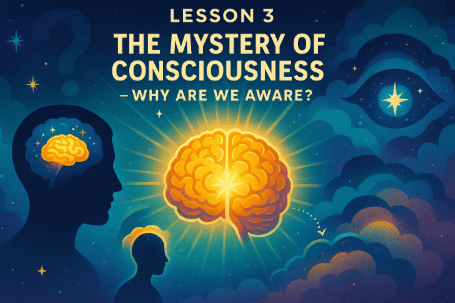
Recap of Lesson 2: The Ghost in the Machine
In the last lesson, we asked whether the mind is separate from the brain. We learned about dualism (mind and body are separate), monism (mind is the brain’s activity), and saw evidence like brain injuries, drugs, and brain scans showing how tightly linked brain and mind are.
But we also discovered the hard problem of consciousness: even if we explain how the brain processes information, we still don’t know why it feels like something to be you.
That’s where we continue today—diving into the most mysterious question of all: Why are we aware?
Part 1: What Is Consciousness?
Consciousness is tricky to define, but most scientists agree it has two main parts:
-
Awareness – The ability to have experiences, like tasting chocolate 🍫, feeling pain, or hearing music.
-
Self-awareness – Knowing that you are the one having the experience. For example, a dog might feel happy, but humans can think, “I am happy right now.”
Think of consciousness as the light that shines on your experiences. Without it, the brain might still process information, but there would be no inner movie playing.
Part 2: Levels of Consciousness
Consciousness is not an on/off switch—it comes in levels.
-
Full wakefulness – Right now, reading this, you’re alert and aware.
-
Daydreaming – Awareness drifts inward.
-
Dreaming (REM sleep) – The brain is active, creating vivid worlds, but awareness of the real world is gone.
-
Deep sleep – Awareness almost vanishes.
-
Coma or anesthesia – Awareness is gone, though the brain still works.
-
Meditative or mystical states – Some people report expanded awareness, feeling “connected to everything.”
This shows consciousness is not fixed but flexible, shifting like a dimmer switch on a lamp 💡.
Part 3: Why Awareness Is Mysterious
Imagine a robot that can recognize faces, answer questions, and even make jokes. Computers like this already exist. But is the robot conscious? Does it feel anything, or is it just processing input and output like a calculator?
This is the puzzle:
-
Your brain is a biological machine of neurons.
-
Machines can process data without awareness.
-
Yet you feel alive, with an inner movie of sights, sounds, and thoughts.
Why?
This is why consciousness is called one of the deepest mysteries of science.
Part 4: Theories of Consciousness
Scientists have tried to explain why we are aware. Here are some leading theories:
1. Global Workspace Theory (GWT) 🖥️
Proposed by Bernard Baars and expanded by Stanislas Dehaene.
-
The brain has many unconscious processes running in parallel (like apps in the background).
-
Consciousness happens when information enters a global workspace and gets broadcast to the whole brain.
-
Example: When you notice a red apple 🍎, many brain processes compete, but the apple “wins” and becomes conscious.
2. Integrated Information Theory (IIT) 🔗
Proposed by Giulio Tononi.
-
Consciousness is about how much information a system can integrate.
-
The brain, with billions of connections, integrates information at a very high level, producing rich awareness.
-
IIT even gives a mathematical number (Φ, phi) to measure consciousness.
3. Higher-Order Thought Theory 💭
This theory says you are conscious when your brain not only has a thought but also knows that it has the thought. Awareness comes from thinking about thinking.
4. Attention Schema Theory 🎯
Proposed by Michael Graziano.
-
The brain builds a “model of attention.”
-
This model is what we experience as consciousness.
-
Just like the body builds a model of itself (a body map), the brain builds a model of its own attention.
Part 5: Is Consciousness Unique to Humans?
Do animals have consciousness? Most scientists believe yes, at least in some form.
-
Dogs feel happiness, fear, and sadness. 🐶
-
Dolphins recognize themselves in mirrors, showing self-awareness. 🐬
-
Octopuses solve puzzles and show curiosity, suggesting awareness. 🐙
So consciousness may not be only human—it might be a spectrum across living beings.
And what about artificial intelligence? Could machines become conscious if they process enough information? That remains an open question.
Part 6: Why Are We Aware at All?
This is the ultimate puzzle. If evolution only cares about survival, why would evolution create awareness instead of leaving us as unconscious robots?
Some possible answers:
-
Survival advantage – Awareness lets us reflect, plan, and imagine future dangers. A conscious human can avoid mistakes before they happen.
-
Social intelligence – Awareness helps us understand others’ minds (“theory of mind”). This makes cooperation possible.
-
By-product – Some scientists think consciousness is not useful by itself but just a side effect of complex brains, like heat given off by a computer.
None of these answers fully solve the mystery. But they help us explore why nature might have given us the gift of awareness.
Part 7: The Hard Problem Again
We return to the hard problem: why does information processing feel like something?
-
A robot camera sees red, but it doesn’t feel redness.
-
Your brain sees red, and you feel a vivid, personal experience.
Why? We don’t know yet. Consciousness remains one of the greatest mysteries—maybe the greatest.
Recap
In this lesson, we learned:
-
Consciousness is awareness plus self-awareness.
-
It has levels: wakefulness, dreams, deep sleep, etc.
-
Theories like Global Workspace, IIT, Higher-Order Thought, and Attention Schema try to explain it.
-
Animals show forms of consciousness too.
-
Evolution may have made us conscious for survival and social reasons.
-
The “hard problem” still has no answer: why does consciousness feel like something?